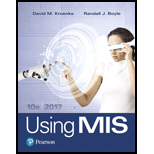
Using MIS (10th Edition)
10th Edition
ISBN: 9780134606996
Author: David M. Kroenke, Randall J. Boyle
Publisher: PEARSON
expand_more
expand_more
format_list_bulleted
Question
Chapter 5, Problem 5.3UYK
Program Plan Intro
E-R model:
- It is a tool for creating data model.
- It is used for developers to describe the content of data model by using two functions called entities and relationships.
Entity:
- It helps the user for tracking something in
database . - Example entities in student database system are Student, Grade, Course, etc.
Relationships:
- Entities have relationships among each other.
- For example, in student database, a Student has a relationship to Major and Student has a relationship to Advisor.
Attribute:
- It used to describe the entity characteristics.
- Example attributes of student entity is Student_id, Student_name, Student_address, etc.
Identifier:
- It is an attribute or group of attribute, but its value is related with one and only one entity instance.
Example of E-R diagram:

Expert Solution & Answer
Want to see the full answer?
Check out a sample textbook solution
Students have asked these similar questions
using r language
show all the work
answer question 3
Chapter 5 Solutions
Using MIS (10th Edition)
Ch. 5.2 - Prob. 1EGDQCh. 5.2 - Prob. 2EGDQCh. 5.2 - Prob. 3EGDQCh. 5.2 - Prob. 4EGDQCh. 5.2 - Prob. 5EGDQCh. 5.2 - Prob. 6EGDQCh. 5.2 - Prob. 7EGDQCh. 5.2 - Consider the adage Never ask a question for which...Ch. 5.3 - Prob. 1SAQCh. 5.3 - Prob. 2SAQ
Ch. 5.3 - Prob. 3SAQCh. 5.3 - Prob. 4SAQCh. 5.8 - Prob. 1SGDQCh. 5.8 - Prob. 3SGDQCh. 5.8 - Prob. 4SGDQCh. 5.8 - Prob. 5.1ARQCh. 5.8 - Prob. 5.2ARQCh. 5.8 - Prob. 5.3ARQCh. 5.8 - Prob. 5.4ARQCh. 5.8 - How are data models used for database development?...Ch. 5.8 - Prob. 5.6ARQCh. 5.8 - Prob. 5.7ARQCh. 5.8 - Prob. 5.8ARQCh. 5 - Draw an entity-relationship diagram that shows the...Ch. 5 - Consider the relationship between Adviser and...Ch. 5 - Prob. 5.3UYKCh. 5 - Prob. 5.4UYKCh. 5 - Study Figure 5-28 to understand the entities and...Ch. 5 - Working with your team, develop a list of seven...Ch. 5 - Modify the E-R model in Figure 5-28 to include a...Ch. 5 - Discuss the advantages and disadvantages of the...Ch. 5 - Transform the data model in Figure 5-28 into a...Ch. 5 - Prob. 5.1CE5Ch. 5 - Fill your database with sample data. Because you...Ch. 5 - Prob. 5.12CE5Ch. 5 - Explain why a one-table database could be stored...Ch. 5 - Prob. 5.14CS5Ch. 5 - Examine the columns in Figure 5-33. Name three...Ch. 5 - Prob. 5.16CS5Ch. 5 - Prob. 5.17CS5Ch. 5 - Explain the statement A database is an abstraction...Ch. 5 - Prob. 5.19CS5Ch. 5 - Prob. 5.2MMLCh. 5 - Prob. 5.21MML
Knowledge Booster
Similar questions
- List down the strenghts and weaknesses of your team project for Capsim Simulation? Explan.arrow_forwardCapsim Team PowerPoint Presentations - Slide Title: Key LearningsWhat were the key learnings that you discovered as a team through your Capsim simulation?arrow_forwardWrite the SQL code that permits to implement the tables: Student and Transcript. NB: Add the constraints on the attributes – keys and other.arrow_forward
- Draw an ERD that will involve the entity types: Professor, Student, Department and Course. Be sure to add relationship types, key attributes, attributes and multiplicity on the ERD.arrow_forwardDraw an ERD that represents a book in a library system. Be sure to add relationship types, key attributes, attributes and multiplicity on the ERD.arrow_forward2:21 m Ο 21% AlmaNet WE ARE HIRING Experienced Freshers Salesforce Platform Developer APPLY NOW SEND YOUR CV: Email: hr.almanet@gmail.com Contact: +91 6264643660 Visit: www.almanet.in Locations: India, USA, UK, Vietnam (Remote & Hybrid Options Available)arrow_forward
- Provide a detailed explanation of the architecture on the diagramarrow_forwardhello please explain the architecture in the diagram below. thanks youarrow_forwardComplete the JavaScript function addPixels () to calculate the sum of pixelAmount and the given element's cssProperty value, and return the new "px" value. Ex: If helloElem's width is 150px, then calling addPixels (hello Elem, "width", 50) should return 150px + 50px = "200px". SHOW EXPECTED HTML JavaScript 1 function addPixels (element, cssProperty, pixelAmount) { 2 3 /* Your solution goes here *1 4 } 5 6 const helloElem = document.querySelector("# helloMessage"); 7 const newVal = addPixels (helloElem, "width", 50); 8 helloElem.style.setProperty("width", newVal); [arrow_forward
arrow_back_ios
SEE MORE QUESTIONS
arrow_forward_ios
Recommended textbooks for you
 A Guide to SQLComputer ScienceISBN:9781111527273Author:Philip J. PrattPublisher:Course Technology Ptr
A Guide to SQLComputer ScienceISBN:9781111527273Author:Philip J. PrattPublisher:Course Technology Ptr Database Systems: Design, Implementation, & Manag...Computer ScienceISBN:9781305627482Author:Carlos Coronel, Steven MorrisPublisher:Cengage Learning
Database Systems: Design, Implementation, & Manag...Computer ScienceISBN:9781305627482Author:Carlos Coronel, Steven MorrisPublisher:Cengage Learning Principles of Information Systems (MindTap Course...Computer ScienceISBN:9781305971776Author:Ralph Stair, George ReynoldsPublisher:Cengage Learning
Principles of Information Systems (MindTap Course...Computer ScienceISBN:9781305971776Author:Ralph Stair, George ReynoldsPublisher:Cengage Learning Principles of Information Systems (MindTap Course...Computer ScienceISBN:9781285867168Author:Ralph Stair, George ReynoldsPublisher:Cengage Learning
Principles of Information Systems (MindTap Course...Computer ScienceISBN:9781285867168Author:Ralph Stair, George ReynoldsPublisher:Cengage Learning Database Systems: Design, Implementation, & Manag...Computer ScienceISBN:9781285196145Author:Steven, Steven Morris, Carlos Coronel, Carlos, Coronel, Carlos; Morris, Carlos Coronel and Steven Morris, Carlos Coronel; Steven Morris, Steven Morris; Carlos CoronelPublisher:Cengage Learning
Database Systems: Design, Implementation, & Manag...Computer ScienceISBN:9781285196145Author:Steven, Steven Morris, Carlos Coronel, Carlos, Coronel, Carlos; Morris, Carlos Coronel and Steven Morris, Carlos Coronel; Steven Morris, Steven Morris; Carlos CoronelPublisher:Cengage Learning

A Guide to SQL
Computer Science
ISBN:9781111527273
Author:Philip J. Pratt
Publisher:Course Technology Ptr

Database Systems: Design, Implementation, & Manag...
Computer Science
ISBN:9781305627482
Author:Carlos Coronel, Steven Morris
Publisher:Cengage Learning

Principles of Information Systems (MindTap Course...
Computer Science
ISBN:9781305971776
Author:Ralph Stair, George Reynolds
Publisher:Cengage Learning

Principles of Information Systems (MindTap Course...
Computer Science
ISBN:9781285867168
Author:Ralph Stair, George Reynolds
Publisher:Cengage Learning

Database Systems: Design, Implementation, & Manag...
Computer Science
ISBN:9781285196145
Author:Steven, Steven Morris, Carlos Coronel, Carlos, Coronel, Carlos; Morris, Carlos Coronel and Steven Morris, Carlos Coronel; Steven Morris, Steven Morris; Carlos Coronel
Publisher:Cengage Learning
